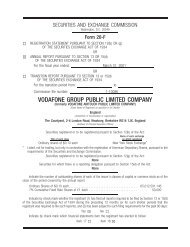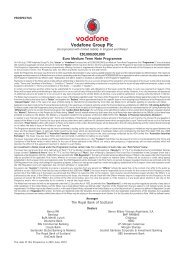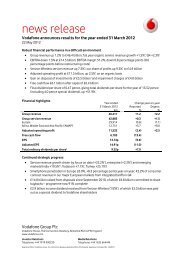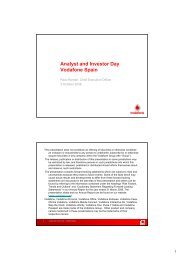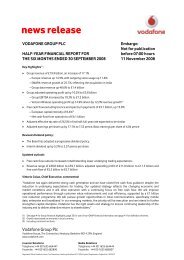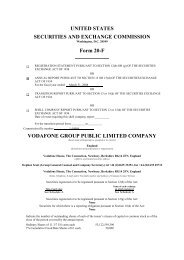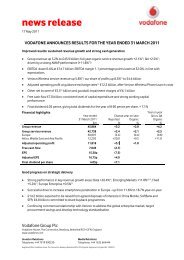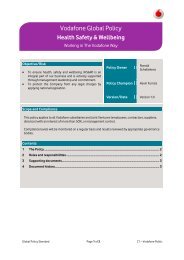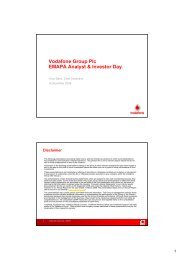Create successful ePaper yourself
Turn your PDF publications into a flip-book with our unique Google optimized e-Paper software.
Key assumptions used in <strong>the</strong> value in use calculations<br />
The key assumptions used in determining <strong>the</strong> value in use are:<br />
Assumption How determined<br />
Budgeted EBITDA Budgeted EBITDA, calculated as adjusted operating profit before depreciation and amortisation, has been based on past<br />
experience adjusted for <strong>the</strong> following:<br />
• voice and messaging revenue is expected to benefit from increased usage from new customers, <strong>the</strong> introduction of<br />
new services and traffic moving from fixed networks to mobile networks, though <strong>the</strong>se factors will be partially offset<br />
by increased competitor activity, which may result in price declines, and <strong>the</strong> trend of falling termination rates;<br />
• non-messaging data revenue is expected to continue to grow strongly as <strong>the</strong> penetration of 3G enabled devices rises<br />
and new products and services are introduced; and<br />
• margins are expected to be impacted by negative factors such as an increase in <strong>the</strong> cost of acquiring and retaining<br />
customers in increasingly competitive markets and <strong>the</strong> expectation of fur<strong>the</strong>r termination rate cuts by regulators<br />
and by positive factors such as <strong>the</strong> efficiencies expected from <strong>the</strong> implementation of Group initiatives.<br />
Budgeted capital expenditure The cash flow forecasts for capital expenditure are based on past experience and includes <strong>the</strong> ongoing capital expenditure<br />
required to provide enhanced voice and data products and services and to meet <strong>the</strong> population coverage requirements<br />
of certain of <strong>the</strong> Group’s licences. Capital expenditure includes cash outflows for <strong>the</strong> purchase of property, plant and<br />
equipment and computer software.<br />
Long term growth rate For mobile businesses where <strong>the</strong> first five years of <strong>the</strong> ten year management plan are used for <strong>the</strong> Group’s value<br />
in use calculations, a long term growth rate into perpetuity has been determined as <strong>the</strong> lower of:<br />
• <strong>the</strong> nominal GDP rates for <strong>the</strong> country of operation; and<br />
• <strong>the</strong> long term compound annual growth rate in EBITDA in years six to ten of <strong>the</strong> management plan.<br />
For mobile businesses where <strong>the</strong> full ten year management plans are used for <strong>the</strong> Group’s value in use calculations,<br />
a long term growth rate into perpetuity has been determined as <strong>the</strong> lower of:<br />
• <strong>the</strong> nominal GDP rates for <strong>the</strong> country of operation; and<br />
• <strong>the</strong> compound annual growth rate in EBITDA in years nine to ten of <strong>the</strong> management plan.<br />
For non-mobile businesses, no growth is expected beyond management’s plans for <strong>the</strong> initial five year period.<br />
Pre-tax risk adjusted discount rate The discount rate applied to <strong>the</strong> cash flows of each of <strong>the</strong> Group’s operations is based on <strong>the</strong> risk free rate for ten year<br />
bonds issued by <strong>the</strong> government in <strong>the</strong> respective market, adjusted for a risk premium to reflect both <strong>the</strong> increased risk<br />
of investing in equities and <strong>the</strong> systematic risk of <strong>the</strong> specific Group operating company. In making this adjustment,<br />
inputs required are <strong>the</strong> equity market risk premium (that is <strong>the</strong> required increased return required over and above a risk<br />
free rate by an investor who is investing in <strong>the</strong> market as a whole) and <strong>the</strong> risk adjustment (“beta”) applied to reflect <strong>the</strong><br />
risk of <strong>the</strong> specific Group operating company relative to <strong>the</strong> market as a whole.<br />
In determining <strong>the</strong> risk adjusted discount rate, management has applied an adjustment for <strong>the</strong> systematic risk to each<br />
of <strong>the</strong> Group’s operations determined using an average of <strong>the</strong> betas of comparable listed mobile telecommunications<br />
companies and, where available and appropriate, across a specific territory. Management has used a forward looking<br />
equity market risk premium that takes into consideration both studies by independent economists, <strong>the</strong> average equity<br />
market risk premium over <strong>the</strong> past ten years and <strong>the</strong> market risk premiums typically used by investment banks in<br />
evaluating acquisition proposals.<br />
Key assumptions for <strong>the</strong> Group’s operations in Germany and Italy are disclosed below under “Sensitivity to changes in assumptions”. During <strong>the</strong> year ended 31 March<br />
2008, <strong>the</strong> most recent value in use calculation for Group’s operations in Spain was based on a pre-tax risk adjusted discount rate of 10.6% (2007: 9.7%) and long term<br />
growth rate of 1.4% (2007: 3.2%).<br />
<strong>Vodafone</strong> Group Plc Annual Report 2008 105




